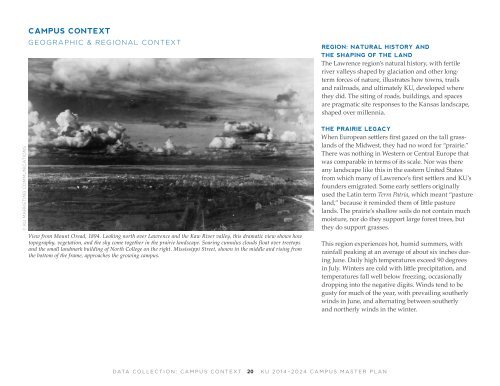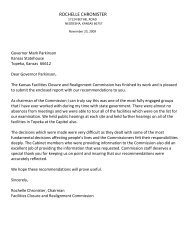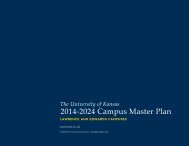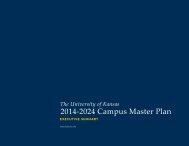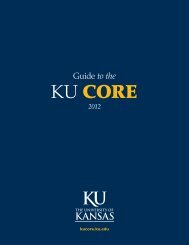KU_Chapter01_DataCollection_2014-06-10
KU_Chapter01_DataCollection_2014-06-10.pdf
KU_Chapter01_DataCollection_2014-06-10.pdf
- No tags were found...
You also want an ePaper? Increase the reach of your titles
YUMPU automatically turns print PDFs into web optimized ePapers that Google loves.
© <strong>KU</strong> MARKETING COMMUNICATIONS<br />
CAMPUS CONTEXT<br />
GEOGRAPHIC & REGIONAL CONTEXT<br />
View from Mount Oread, 1894. Looking north over Lawrence and the Kaw River valley, this dramatic view shows how<br />
topography, vegetation, and the sky come together in the prairie landscape. Soaring cumulus clouds float over treetops<br />
and the small landmark building of North College on the right. Mississippi Street, shown in the middle and rising from<br />
the bottom of the frame, approaches the growing campus.<br />
REGION: NATURAL HISTORY AND<br />
THE SHAPING OF THE LAND<br />
The Lawrence region’s natural history, with fertile<br />
river valleys shaped by glaciation and other longterm<br />
forces of nature, illustrates how towns, trails<br />
and railroads, and ultimately <strong>KU</strong>, developed where<br />
they did. The siting of roads, buildings, and spaces<br />
are pragmatic site responses to the Kansas landscape,<br />
shaped over millennia.<br />
THE PRAIRIE LEGACY<br />
When European settlers first gazed on the tall grasslands<br />
of the Midwest, they had no word for “prairie.”<br />
There was nothing in Western or Central Europe that<br />
was comparable in terms of its scale. Nor was there<br />
any landscape like this in the eastern United States<br />
from which many of Lawrence’s first settlers and <strong>KU</strong>’s<br />
founders emigrated. Some early settlers originally<br />
used the Latin term Terra Patria, which meant “pasture<br />
land,” because it reminded them of little pasture<br />
lands. The prairie’s shallow soils do not contain much<br />
moisture, nor do they support large forest trees, but<br />
they do support grasses.<br />
This region experiences hot, humid summers, with<br />
rainfall peaking at an average of about six inches during<br />
June. Daily high temperatures exceed 90 degrees<br />
in July. Winters are cold with little precipitation, and<br />
temperatures fall well below freezing, occasionally<br />
dropping into the negative digits. Winds tend to be<br />
gusty for much of the year, with prevailing southerly<br />
winds in June, and alternating between southerly<br />
and northerly winds in the winter.<br />
DATA COLLECTION: CAMPUS CONTEXT<br />
20<br />
<strong>KU</strong> <strong>2014</strong>–2024 CAMPUS MASTER PLAN


